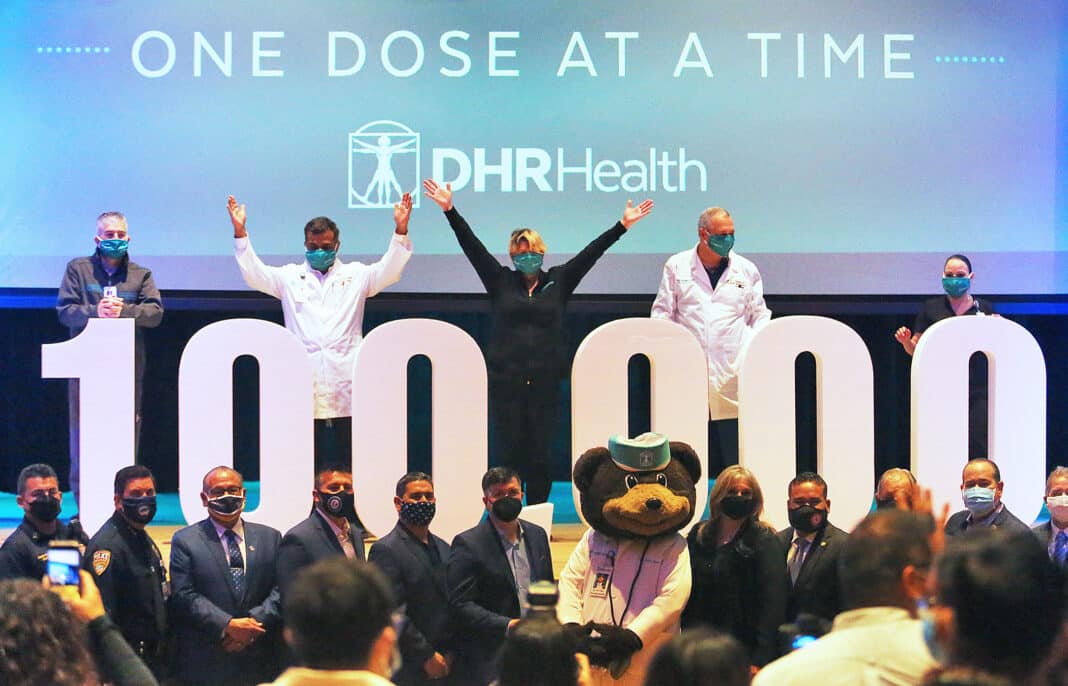Since healthcare providers started administering COVID-19 vaccinations to eligible individuals in mid-December, about 10% of people in the Rio Grande Valley have been fully vaccinated as of March 12 while 18% have received at least one dose of the vaccine.
The data, made available by the Texas Department of State Health Services, shows just how far officials have progressed in their efforts to distribute the COVID-19 vaccine throughout Texas where a total of 5,246,949 people have received at least one dose and 2,781,088 people, or 9.6% of Texans, have been fully vaccinated.
While about 10% of Rio Grande Valley residents are now fully vaccinated, the percentage of people vaccinated in each county varies.
In Hidalgo County a total of 83,465 people, or 9.6% of the total county population, have been fully vaccinated while 145,182 people, or 16.7%, have been vaccinated with at least one dose of the available vaccines as of March 12.
A higher percentage of Cameron County’s population, 11.4% which is about 48,206 people there, have been fully vaccinated. About 86,721 people, or 20% of county residents, have received at least one dose.
Starr County is leading the pack in the number of residents who have received at least one dose of the vaccine with 16,983 people, or 26% of their total population.
As for people who have been fully vaccinated, about 11% of Starr County’s population, or 6,848 residents, now fall under that category.
In Willacy County, 1,800 people, or 8.4%, have been fully vaccinated while a total of 3,309 county residents, or 18%, received at least one dose.
Dr. Emilie Prot, regional medical director for DSHS Public Health Region 11, said the state was allocating and sending out all the vaccine doses given to the state but acknowledged the overall process had turned out to be slower than expected.
“We have more of a need than there is supply and we’re still in that same case scenario where they’re still not enough supplies from the manufacturers,” Prot said, referring to Moderna, Pfizer-BioNTech, and Johnson & Johnson whose vaccines received emergency-use authorization from the Food and Drug Administration.
“Those are still produced at lower numbers than expected for now and I think that they are looking into ways that they can increase that,” Prot said. “Of course, the Johnson & Johnson (vaccine) is just one dose and so that’s going to increase our fully vaccinated rates a lot quicker compared to our other two which take … they have to be administered 21 and then 28 days apart so it takes a little bit longer, altogether, to have a fully vaccinated person.”
Earlier this week, DSHS announced it was increasing the pool of Texans eligible for the vaccine by opening it up to individuals 50 and older starting Monday.
“When we looked at the epidemiological data, this group bears a significant risk of severe disease, hospitalization and death,” said Imelda Garcia, DSHS associate commissioner, noting that 20% of the COVID-19 deaths in the state were among people aged 50 to 64.
“And when you people 60 and older, the combined group accounts for over 93% of all COVID-related deaths,” Garcia said.
However, despite the arrival of Johnson & Johnson vaccine, which only became available this month, Garcia announced that next week there would be fewer first dose vaccines allocated to counties around the state.
“This is happening for two different reasons — the federal government has sent out all the Johnson & Johnson vaccines that had been manufactured this week,” Garcia said, “the states are getting a lot less J&J this coming week.”
She added that while the state will still be receiving some of those doses this coming week, as of Thursday DSHS had not received final numbers and therefore those doses would not be reflected in the list how much vaccine the state would be allocating to providers.
While there would be fewer vaccines, the state is still expected to receive more than 800,000 doses this coming week, including 625,000 doses that they would send to providers.
Dr. Prot praised their partners in Public Health Region 11 — a 19-county area in South Texas that includes the Rio Grande Valley — as well as their local health departments in the region and state officials in their handling of the vaccine rollout. However, she understood the frustrations among the public.
“Of course, I think it’s also a little bit frustrating because there isn’t one single way to access or one area where you can look at every single clinic that’s ongoing — some you can sign up by phone, some you sign up by internet,” Prot said. “Every week is different and depending on the provider that’s providing that vaccine, some might know just that week what they’re getting so I think that’s also added to the frustration.”
“But this is happening in every single country around the world,” Prot added, “so we’re waiting right now and I know the lab’s also working 24 hours, around the clock, so everyone’s working at best capacity right now and so we’re doing as best as we could.”





